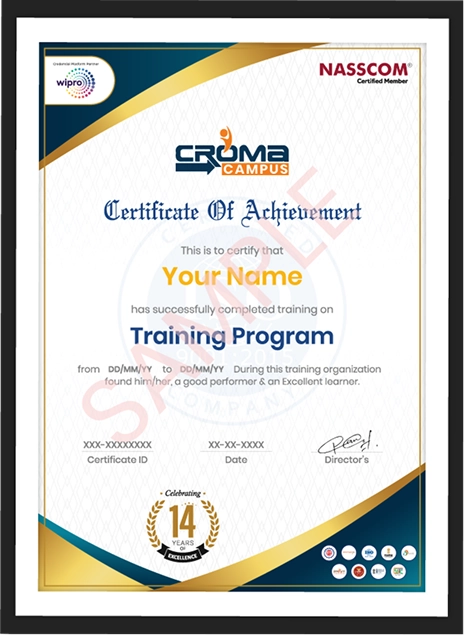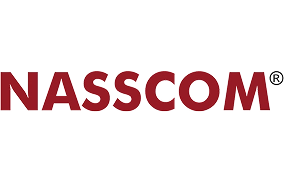Course Design By
Nasscom & Wipro
Helping learners understand the Salesforce cloud architecture and its multi-tenant structure.
Teaching core admin concepts such as user profiles, permission sets, roles, and org-wide defaults.
Enabling students to create Reports, Dashboards, and Business Analytics inside Salesforce.
Introducing Apex code for triggers, classes, exception handling, and writing test classes.
Guiding learners to build custom apps using Lightning Web Components (LWC).
Allowing practice with SOQL and SOSL for database queries.
Explaining how to automate processes using Flows, Process Builder, and Approval Rules.
Training in deployment methods, change sets, and sandbox testing.
Live instructor-led classes by certified Salesforce professionals.
Real-time project work with sandbox-based practice sessions.
Free support for certification registration and mock test practice.
College students or fresh graduates from any stream (Arts, Commerce, Science, Engineering)
Working professionals looking to switch careers to CRM or cloud technology
Software testers, support staff, or BPO professionals aiming to upskill
Sales or marketing executives wanting to automate business processes
Anyone with interest in cloud computing or app development
Understanding Cloud, CRM, and SaaS
Salesforce editions and architecture
Org Setup, Users, Profiles, Roles
Objects, Fields, Validation Rules
Reports, Dashboards, Page Layouts
Data Import/Export
Data Loader, Schema Builder
OWD, Sharing Rules, Permission Sets
Field-level and Record-level security
Workflow Rules, Process Builder
Flow Builder and Approval Process
Classes, Triggers, Exceptions
Collections, Loops, DML Operations
Component Lifecycle
Events, JS controllers, HTML templates
Querying data, relationships, filters
Test Classes, Code Coverage
Developer Console and Debug Logs
Change Sets, Sandboxes
Introduction to CI/CD in Salesforce
End-to-end app implementation
Using Admin + Developer features
Salesforce Certified Administrator
Salesforce Platform Developer I
Salesforce App Builder Certification
Salesforce Advanced Administrator (optional advanced track)
Work in Salesforce implementation companies or consulting firms.
Apply for remote Salesforce roles in global companies.
Get jobs in sectors like banking, retail, education, IT, telecom, etc.
Move into advanced Salesforce areas like CPQ, Marketing Cloud, or Einstein AI.
Use Salesforce knowledge as a base to grow into Solution Architect role.
A fresher working as a Salesforce Administrator can earn between 3.5 to 5.5 LPA.
A fresher with developer knowledge from this course can earn around 4.5 to 6.5 LPA.
Entry-level positions like Salesforce Support Executive or CRM Analyst can offer 3 to 5 LPA.
Knowledge of JavaScript or SQL along with Salesforce can push your package above 7 LPA.
Start as a Salesforce Admin or Junior Developer
Move up to Salesforce Consultant or Integration Engineer
Grow into roles like Business Analyst, Technical Architect, or Project Manager
Local job openings are rising for Salesforce-skilled candidates.
Salesforce is used in every sector-from education to healthcare to e-commerce.
Salesforce Institute in Vizag gives access to remote jobs and freelance projects.
It offers one of the highest Return on Investment (ROI) in terms of cost vs salary.
Peaceful lifestyle and growing tech infrastructure make it perfect for freshers.
Salesforce Administrator
Salesforce Developer
Salesforce QA/Test Engineer
Lightning Developer
CRM Support Executive
Functional Consultant
Integration Specialist
Business Analyst
Manage and secure user access in Salesforce
Create custom fields, objects, and validation rules
Write Apex triggers, test classes, and use SOQL to fetch data
Create automated workflows and approval processes
Work with clients to gather business requirements
Troubleshoot bugs and maintain system performance
Integrate Salesforce with external APIs or platforms
IT & SaaS (Software as a Service) companies
Banking, Financial Services, and Insurance (BFSI)
Healthcare and Hospitals
E-commerce and Retail Chains
Telecom & Internet Service Providers
Manufacturing and Distribution
Education & EdTech companies
we train you to get hired.

By registering here, I agree to Croma Campus Terms & Conditions and Privacy Policy
Course Design By
Nasscom & Wipro
Course Offered By
Croma Campus
Stories
success
inspiration
career upgrade
career upgrade
career upgrade
career upgrade
You will get certificate after
completion of program
You will get certificate after
completion of program
You will get certificate after
completion of program
in Collaboration with

Empowering Learning Through Real Experiences and Innovation
we train you to get hired.
Phone (For Voice Call):
+91-971 152 6942WhatsApp (For Call & Chat):
+91-971 152 6942Get a peek through the entire curriculum designed that ensures Placement Guidance
Course Design By
Course Offered By
Ready to streamline Your Process? Submit Your batch request today!
No. You don’t need to be from IT or engineering. Anyone can learn with interest and effort.
You’ll get access to recordings and can attend backup classes.
Most students get placed within 2–3 months after completing Salesforce Course in Vizag and certification.
Yes. Admin and business analyst roles don’t require much coding. Salesforce Training in Vizag teaches both.
Yes. You will get a course completion certificate that you can share on LinkedIn and job portals.

Highest Salary Offered
Average Salary Hike
Placed in MNC’s
Year’s in Training

fast-tracked into managerial careers.
Get inspired by their progress in the
Career Growth Report.
FOR QUERIES, FEEDBACK OR ASSISTANCE
Best of support with us
For Voice Call
+91-971 152 6942For Whatsapp Call & Chat
+91-9711526942




















